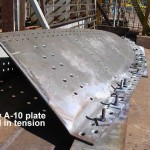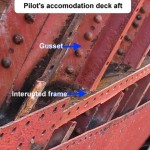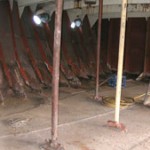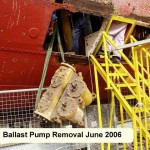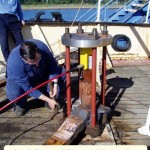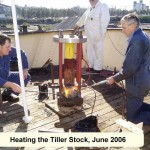John Oxley Restoration
Update June 2006
Hull
| • | All the boiler room floors have now been completed and fitted into the hull. The stringers and the keelson in the boiler |
| room have been repaired. This has created a much stronger midship’s structure. Most of the repaired boiler stools are | |
| back in place. The boilers will not be bearing on the stools till the lower hull plating has been restored. | |
| • | Plates A-1 port and starboard have been refitted and riveted. It was hard and hot work with the limited access in the |
| aft tunnel. | |
|
|
|
| • | Progress has been made with the complex shape of plate A-10 starboard. It has a curve lengthwise and vertically. It is a |
| concave shape. During the original ship’s construction. it would have been heated in a furnace and hammered with | |
| wooden mallets to a mold. We do not have a furnace of that size and have attempted to stress the plate with selective | |
| heating into place. We will fabricate A-10 port the same way and mount both plates at the same time to the frames to | |
| balance the stress on the ship’s frame. | |
| • | So far 28 plates have been replicated and are fitted to the hull. Of these, 6 are riveted in place. A further 8 plates for the |
| F-strake, port and starboard, have been replicated and are awaiting to be fitted on the hull. | |
| • | A better plate handling system has been fabricated for the workshop by using a spreader beam with two chainblocks |
| and a chain driven traveller on the overhead beam. | |
| • | The concrete from the Pilot’s accomodation flat has been removed and shows that most of the floor plates near the hull |
| are in a bad state. Most will need replacement. Unfortunately the hull frames are interupted at this deck level. | |
| The frames above and below the deck are attached to the deck with gussets. Taking out a floor plate means that the | |
| frames above the floor need to be supported to carry the structure above this floor level. | |
|
|
|
Engineering
Recent engineering work has centred on dismantling and removal of engine room auxiliaries. The intention is to clear their considerable bulk away from the hull so the plating teams can work unhindered. Another need for removal is their repair and then replacement back inside the hull while hull plates are removed.
A major daunting task has been the removal of the tiller from on top of the rudder stock. Work reports indicate this was last done in about 1962. The components are large and heavy, and a shrink fit combined with age and rust was likely.
We have a sponsor-donated Enerpac 50T hydraulic jack available. Calculations revealed that a puller for the tiller would be heavy indeed. A piece of 65 mm. steel plate was donated by the yard next door. This was cut to a rough circle of about 19″ diameter. As this puller is intended for the vessel, it was decided to make a permanent tool for the ship. Accordingly, it was machined smooth. Four 1 5/8″ holes were drilled for the tie bolts were turned up and threaded by Bill in our machine shop.
Scraps of the 65 mm. plate ended up as strongbacks to go under the tiller itself. The tiller puller has taken some weeks to make, however like most fitting and machining jobs, the actual job takes far less time than the time taken to make the tooling.
One Saturday morning, the engineers took over the gas cylinder sets – no hull team cutting and riveting would be possible as all the gas-gear was needed for this job.
First task was to remove the key – this had been in place for over 40 years and it fought all the way! The puller was then lifted into place along with the jack and set up. After much heating and not so gentle sledge hammer blows to shock the tiller, it started to move. To reach this point (before lunch) was gratifying as it was known then that the next stage in the job could be accomplished.
The next task is to disconnect the rudder stock from the rudder itself, this will release the rudder so that it can be lowered to the dock for repairs.
Planning
Progress has slowed with the complexity of fitting and riveting of plates A-1 port and starboard, and the fabrication of plate A-10 starboard. A number of plates are awaiting to be bolted onto the hull frames. Significant time was also spent on assisting the Warratah refit. It involved the replication of 10 hull plates and riveting.

